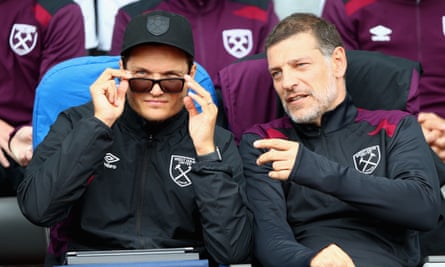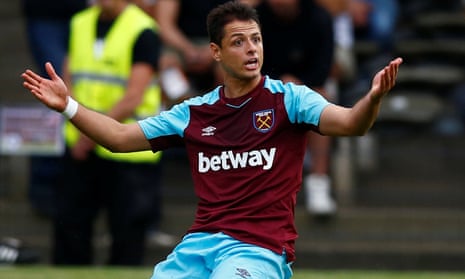Guardian writers’ predicted position 10th (NB: this is not necessarily Jacob Steinberg’s prediction but the average of our writers’ tips)
Last season’s position 11th
Odds to win the league (via Oddschecker) 350-1
Though there was nothing straightforward about West Ham United’s move to the London Stadium, they could be forgiven for thinking everything was possible once the process was finally over. But it was only stage one of their journey. They had visions of where they wanted to end up, of upsetting the hierarchy of power in London and ultimately challenging Europe’s elite, but what came next was the hard part. Stage two is where West Ham got stuck, as though they had the map upside down, and after a year in their new home the hallowed next level feels no closer than when Upton Park was home.
Their lap of honour after their final home match last season – a 4-0 defeat by Liverpool that followed a similar pattern to the majority of their experiences against the top sides– took place in front of rows of empty seats. If anything, while the strongest teams got even better, West Ham went backwards. Unable to push on, they find themselves playing a game of catch-up in which those leading the race always seem to be moving further into the distance. That complicates their plans. There is a disconnect between knowing what they want to achieve and working out how to attain it.
In attempting to shatter the glass ceiling, it was hammered home to them that simply moving to a different east London postcode was not enough on its own. When they tried to gain access to the most exclusive spots, they were told their name wasn’t on the list. Nobody who mattered cared about their new stadium. Not yet.
Last summer’s recruitment was a disaster. From the eight players signed for the first team, Álvaro Arbeloa, Jonathan Calleri, Ashley Fletcher, Havard Nordtveit and Simone Zaza have left. Far from challenging for European football, West Ham spent the campaign dogged by relegation concerns and the club decided against offering Slaven Bilic a new contract this summer. The manager has a year left on his current deal and there are doubts over his tactical acumen.
The hope for West Ham is their recent tribulations could work in their favour by relieving some of the pressure caused by the move. Tension reigned at the London Stadium last term, raising anxiety on and off the pitch, and it always did concern Bilic when he heard people talking about the Champions League during pre-season. “We want to go there but first we have to put solid cornerstones and build on it,” he said when West Ham were struggling in April. “The expectations were big. New stadium, new training ground, possible new signings. People are always positive and optimistic. But what I didn’t like was the talk of the Champions League.”
A more realistic outlook has led to a shift in West Ham’s focus in the transfer market. Last summer they looked to the continent in an attempt to find canny cheap bargains but lumbered themselves with duds. They targeted a top striker but ended up cancelling Zaza’s loan after half a season.
This time they have been more clinical, looking to establish themselves in the top half by signing proven Premier League produce. They began the window by signing Pablo Zabaleta on a free, returned to Manchester City to bring Joe Hart in on loan and enhanced their attacking options by spending a combined £40m on Marko Arnautovic and Javier Hernández. They have also signed the 18-year-old Montenegrin Sead Haksabanovic from the Swedish side Halmstad for £3m.

“We had a policy up to now to buy players for tomorrow, not today,” David Sullivan, West Ham’s co-owner, said last month. “Long term it’s not a great strategy but short term it is. Hopefully we’ll buy one or two more players, investments in the future, while at the same time doing what’s best for the club.”
The benefits of that approach are clear. West Ham know what they are getting. All being well, they do not have to brace themselves for any nasty surprises. Despite an indifferent couple of years, Hart is an excellent goalkeeper who has the motivation of protecting his status as England’s No1 before the World Cup. Few right-backs have been as dependable as Zabaleta in the past few years and the Argentinian should raise standards in a squad crying out for more personality. The strutting Arnautovic, West Ham’s record signing, has offered glimpses his of swagger in pre-season. So elusive in the penalty box, Hernández scored 59 goals in 157 games for Manchester United.
In today’s inflated market, it is hard to argue with £24m for Arnautovic and £16m for Hernández. If their end-product lives up to expectations, West Ham will have an excellent chance of a smoother season.
The downside, however, is that it is not easy to detect a plan at West Ham. Clubs at their level are forced to compromise just to keep pace with the competition but the profiles of their signings are worth questioning. It is not only that Zabaleta is 32, it is that West Ham signed the 33-year-old José Fonte and the 29-year-old Robert Snodgrass for a combined £18m in January. Their short-termism is understandable for now but they will continue to lag behind if it strays into long-term policy.
Another concern is that West Ham have yet to solve the lack of pace identified by Bilic at the end of last season. It would be wrong to assume that Bilic’s desire for superior athleticism was down to the size of the pitch at the London Stadium – which is 5m longer but no wider than Upton Park’s – but everything to do with his team’s lethargic play. Looking back to the start of his tenure, it is notable that West Ham counterattacked effectively in wins at Arsenal, Liverpool and City, with Diafra Sakho, strong and fast, outstanding as a lone striker. With Hernández up front, it is unlikely there will be a repeat of West Ham waiting until late November for a striker to score a goal. Nonetheless it will be intriguing to see whether the former Bayer Leverkusen forward’s physique will allow him to act as a focal point in the Premier League.
That said, West Ham could have one of the more watchable attacks in the division. Michail Antonio is powerful and versatile, Arnautovic is capable of moments of magic and Manuel Lanzini fills the creative void left by Dimitri Payet’s ignominious return to Marseille, while André Ayew has a nose for goal despite meagre contributions in general play.
The disappointing Snodgrass and Sofiane Feghouli could move on before the window shuts, though, and West Ham need more cover for Hernández. Enner Valencia has returned to Mexico, Andy Carroll and Sakho both struggle to stay fit and that leaves Toni Martínez, a raw Spaniard who spent the second half of last season on loan at Oxford United.
There should be funds available for further improvements. West Ham have managed to shift deadwood from their squad, selling Darren Randolph and Fletcher to Middlesbrough and Nordtveit to Hoffenheim, and it feels as though their business should not be done yet. The makings of a good team are there but they need more drive and nous in central midfield. Cheikhou Kouyaté, Mark Noble and Pedro Obiang are all decent players, while Edimilson Fernandes is promising, but West Ham were often overrun and outplayed in the middle.
That placed strain on one of the most disorganised defences in the league. Hart could be busy. Despite finishing 11th, West Ham conceded 64 goals. They shipped two goals or more in half their league games.
Angelo Ogbonna and Winston Reid are fine centre-halves, even if the latter’s standards have dipped recently, and while Fonte has been underwhelming, James Collins is a solid alternative in times of need despite his advancing years. On the left, Aaron Cresswell may struggle to keep the improving Arthur Masuaku out of the team. Yet West Ham’s defensive record does Bilic few favours. His farcical attempt to turn Antonio into a right-back raised serious questions about his judgment, and unbalanced the team. If Zabaleta’s age catches up with him, Bilic will be forced to turn to Sam Byram, who is yet to gain his trust.

Despite his popularity, Bilic has divided opinion. There were times last season when West Ham barely functioned, when they looked devoid of any tactical plan, a team without a way of playing. On the other hand, his team have often shown defiance in difficult moments, recovering from poor starts or bouncing back after winless runs, and Bilic has occasionally come up with tactical surprises such as switching systems from 4-2-3-1 to a 3-4-3.
He caught out Mauricio Pochettino’s Tottenham Hotspur in May, on a raucous night that gave West Ham a tantalising glimpse of better times at the London Stadium. Their first season in E20 was fraught with difficulties, from the running track surrounding the pitch to early crowd disorder, and one player privately said the experience of playing there was “terrible”.
Perhaps everything will settle down this term. Yet a reminder of the price of West Ham’s status as tenants in a multi-purpose, converted athletics stadium is that the time required to make it suitable for football once the World Athletics Championships finish on Sunday means they will not play there until 11 September. It remains a house rather than a home, another adjustment for a club striving for a new identity, still trying to find its way.

Comments (…)
Sign in or create your Guardian account to join the discussion